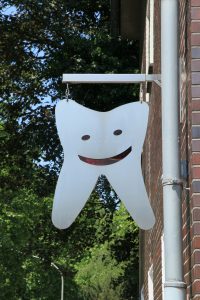
By Frank Vincentz via Wikimedia Commons
I get approached fairly often by colleagues and regular folks with ideas for radio show topics. With over 450 hour-long radio broadcasts so far, you may imagine that staying topical and interesting is something I hope to do. But in all those shows over the past nine years, I have never done a show about dental health in children. Not too surprising, I suppose, since my specialty is adult internal medicine, meaning I know very little about children’s health and I know just about nothing about teeth. (I think there are 32 or them in the human mouth, right? Or maybe it is 28? They don’t teach teeth in medical school).
So when Dr. Eileen Crespo approached me to do a show about the oral health of children, I was intrigued. Dr. Crespo is a pediatrician who has a keen interest and lots of expertise in kids’ dental health. She suggested we include two our Hennepin’s terrific pediatric dentists and – voila – we had a radio show.
So I though I’d explore a bit why the dental health of children should matter to all of us of any age. Here’s the gang who helped me in the WCCO studios in downtown Minneapolis for the show. That’s Dr. Crespo on the left, and next to her are two pediatric dentists, Dr. Andrea Leyland and Dr. Elisabeth Fulling. Click their names to learn more!
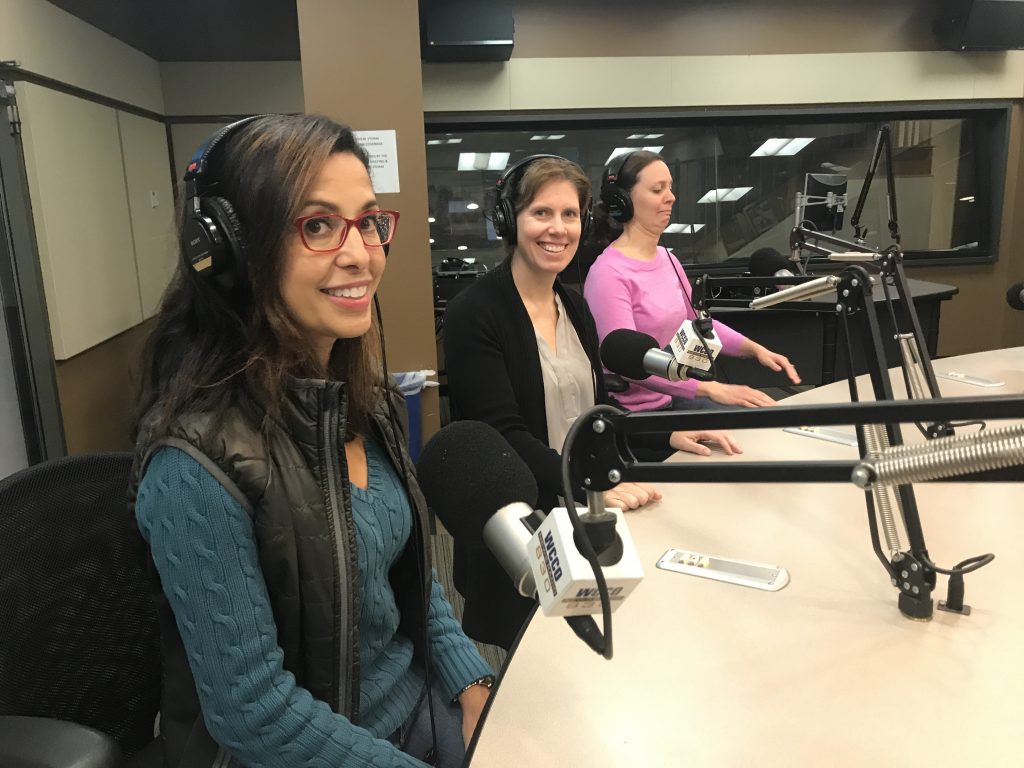
As always, I invite you to listen to the podcast of the show (it is shorter with no interruptions when in podcast form). When looking through the podcasts, select Healthy Matters show #456 from October 1, 2017.
In this post I’ll look at:
- Why the dental care of children matters
- Some basic tips for promoting healthy teeth in kids
- A call for more dentists for children
Cavities predict worse health
Warning, gross rotting tooth picture ahead . . .
I have had tooth cavities, just like most of you. I can still see the two fillings in the upper teeth, way in the back, on the chewing surface. One of them is the silver amalgam filling that my talented but rather old-school dentist put in about 40 years ago. That old-timer dentist sadly is no longer alive but he will forever be emblazoned in my memory for putting his big ol’ hands in my mouth without gloves. It was a different era back then. Anyway, his filling in my upper tooth is still working just fine so I guess he knew what he was doing. Gloves or not.
As we learned on the radio program, dental caries (the fancy word for cavities which in turn is just a fancy word for “hole in your tooth”) are a big deal in children. That little hole in the enamel of the tooth can eat its way deeper, all the way down to the roots of the tooth, which can mean a root canal or tooth extraction in the future. Poor teeth, in turn, lead to lots of other health problems (or conversely, may be a surrogate marker for poor health sort of like a canary in a coal mine).
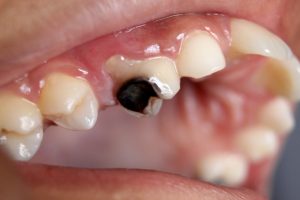
Cavity in a 10-year boy, photo by Suyash.dwivedi via Wikimedia Commons
Here’s my simplistic chain of events . . .
Consider the kid with bad teeth. It can lead to (or be caused by):
- Poor eating habits.
- Which can lead to more cavities
- Which can lead to rotting teeth that need to be pulled
- Which can lead to challenges eating healthy foods in the future
- Which can lead to obesity and other nutritional problems
- Which can lead to lots of expensive dental and doctor visits
All of which can be accompanied by social stigma in an age where perfect teeth are so common in people who can afford them through braces and great dental care. Poorer kids don’t have that opportunity much of the time.

Elisabeth Fulling, DDS
Here’s more:
Did you know that cavities are a “transmissible disease”? Ew. Want to know why cavities matter?
Listen to a great discussion on the October 1, 2017 podcast with pediatric dentist Elisabeth Fulling, starting around time 14:15 for her comments about the importance of preventing cavities.
Pediatric dentistry means singing to the kids
So one of my fillings is the amalgam type. Most of you probably know the silvery appearance (but no, it is not made of silver!) of these types of fillings. I have one. But I also have one that is white. And those are only two of the options. Did you know that there are other options for treating kids and cavities? Things like crowns? I didn’t know that either. To hear more about these options, listen to kids’ dentist Andrea Leyland on the podcast. She talks about it at time 16:23.
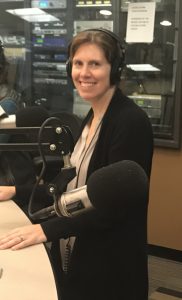
Andrea Leyland, DDS
You know what’s cool about Dr. Leyland? Well . . . she used to be a dentist in the Navy, meaning she worked on the teeth of lots of young adults. And it apparently wasn’t pretty, the condition of the teeth that Lieutenant Leyland saw. So she went into pediatric dentistry, and now she sings to her patients in a career dedicated to preventing the type of dental badness she saw in the military She talks about that on the podcast, too. Singing to her young patients, showing TV shows during procedures. Now that’s the way to get kids comfortable with the dentist.
Wish I had that when I was a kid! My glove-less dentist had 1970s-era shag carpeting and an x-ray machine that rattled like a Sherman tank. Amazing I survived the whole ordeal. But I still have that filling he put in . . . . !
Tips for parents on healthy teeth in your wee little ones

Eileen Crespo, MD
So having cavities is bad for kids, and treating them is good but probably a bit too late. Much better is preventing cavities in the first place. Here are some rapid-fire tips for children’s dental health, from all three of my guests from the show:
- Start brushing early. A child’s tooth (or teeth) should be brushed with a fluoride toothpaste from the first day they erupt. So basically if there is a visible tooth, you outght to be brushing it. This is usually around 6 months of age but can be earlier or later.
- Brush an infant’s or small child’s teeth with a pediatric toothbrush and a very small amount of toothpaste that has fluoride. Dr. Crespo suggested toothpaste in amounts about the size of a grain of rice.
- Fluoride matters. I know, there is controversy, but I don’t buy in to the worries about it. Fluoride works two ways: First, it works topically in toothpaste by promoting remineralization of the enamel. Loss of enamel leads to holes in the teeth = cavities! Second, fluoride works systemically when swallowed by strengthening the crystal (mineral) formation of growing teeth. This is why fluoride is put in municipal water supplies and why my teeth were pretty darn healthy while growing up drinking the fluoridated Mississippi River water from the Minneapolis tap. (Minneapolis tap water is still the best in the world, in my opinion!). One big threat to fluoridated water is the bottled water that many people drink. Do with that information what you will.
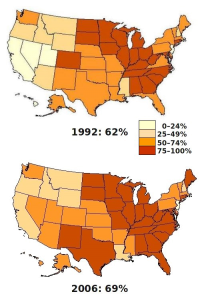
Percent of population served by fluoridated water supplies, from CDC public domain)
- Fluoride is available in toothpaste, treatments from a dentist, oral supplements that you swallow, and of course, many municipal water systems. They’re all good for strengthening enamel through re-mineralization which counteracts the de-mineralization of acid in the mouth.
- The first visit to a pediatric dentist should be by age one. Some people think that deciduous teeth (the baby teeth that fall out like leaves fall off deciduous trees) are not important so you can wait to go to the dentist. Not true! Go early, go often.
- Avoid juice and soda pop. All three of my radio show guests recommend water as the drink of choice for your child. Soda pop – diet or regular – is a no-no. Juice, contrary to common belief, is also a no-no. It is just liquid sugar which interacts with mouth bacteria to promote acid and . . . you guessed it . . . cavities. So give your kids water right from an early age. Trust the pediatric experts. For more on juice and diet and teeth from Dr. Crespo, listen to the podcast at minute 22:54. You can even hear me reminisce about putting cups full of sugar into my Kool-Aid.
In summary: Brush teeth as soon as they erupt. First trip to the dentist by first birthday. Flouride. Water for the kiddos, not juice or pop.
A call for more pediatric dentists
Here’s something I didn’t know, but I do now. Dr. Leyland said on the show (listen to this discussion at minute 32:35 on the podcast of the 10/1/2017 show) that the state of Minnesota, with some of the best healthcare in the United States, has a pediatric dentist available in only 20 of the 87 counties. That’s unacceptable. I’ll bet most are in the urban centers, meaning lots of people in this terrific state who don’t live in the Twin Cities or other cities are out of luck.

Hennepin Healthcare Clinic and Specialty Center
At Hennepin, we are trying to address that a bit. In addition to the general practice dental residency that we have had since 1976, we are now launching a new advanced education residency in pediatric dentistry. We need more of this and I’m proud to be part of a great department of dentistry and pediatrics at HCMC. Particularly exciting that we are opening the Delta Dental Oral Health Center at HCMC. Located in our new Clinic and Specialty Center (which opens March 26, 2018), it will be Minnesota’s state-of-the-art dental care center.
Click here for more on the Clinic and Specialty Center, including video tours with me.
Thanks to Drs. Crespo, Leyland, and Fulling for helping us out with our kids and their teeth. And thanks for hanging out here on MyHealthyMatters. Subscribe below if you wish!
-David
Follow me on Twitter @DrDavidHilden
